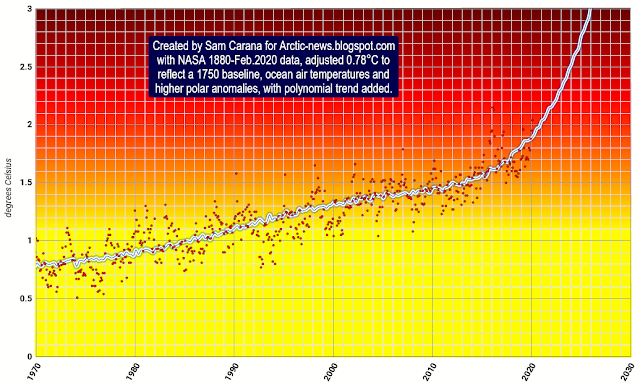It's time to stop denying how precarious the situation is.
Remember the Paris Agreement? In 2015, politicians pledged to hold the global temperature rise to well below 2°C above pre-industrial levels and pledged they would try and limit the temperature rise to 1.5°C above pre-industrial levels. Well, an analysis by Sam Carana shows that it was already more than 1.5°C above pre-industrial when the Paris Agreement was reached.
In Sam Carana's analysis, the year 1750 is used as the baseline for pre-industrial. The analysis shows that we meanwhile have also crossed the 2°C threshold (in February 2020) and that the temperature rise looks set to rapidly drive humans and eventually most if not all species on Earth into extinction.
Yet, our politicians refuse to act!
Accelerating temperature rise
Indeed, there are indications that the recent rise is part of a trend that points at even higher temperatures in the near future, as also discussed at this analysis page. Polynomial trends can highlight such acceleration better than linear trends. The 1970-2030 polynomial trend in the image below is calculated over the period from 1880 through to February 2020. The trend points at 3°C getting crossed in 2026.
In above image, the January 2020 and February 2020 anomalies are above the trend. This indicates that the situation might be even worse.
A polynomial trend calculated over a shorter period can highlight short-term variation such as associated with El Niño events and can highlight feedbacks that might otherwise be overlooked. The 2010-2022 trend in the image below is calculated with 2009-Feb.2020 data. The trend indicates that 2°C was crossed in February 2020, and looks set to keep rising and cross 3°C in 2021, more specifically in January next year, which is less than a year away.
Such a steep rise is in line with unfolding developments that are causing the aerosol masking effect to fall away, such as a decrease in industrial activity due to COVID-19 fears. The image below shows a potential rise of 18°C or 32.4°F from 1750 by the year 2026.
Above image was posted more than a year ago and illustrates that much of this potentially huge temperature rise over the next few years could eventuate as a result of a reduction in the cooling now provided by sulfates. In other words, a steep temperature rise could result from a decline in industrial activity that is caused by fears about the spread of a contagious virus, as also discussed in the video at an earlier post.
The situation is dire and calls for immediate, comprehensive and effective action, as described in the Climate Plan.
Links
• Analysis: Crossing the Paris Agreement thresholds
https://arctic-news.blogspot.com/p/crossing.html
• A rise of 18°C or 32.4°F by 2026?
https://arctic-news.blogspot.com/2019/02/a-rise-of-18c-or-324f-by-2026.html
• How much warming have humans caused?
https://arctic-news.blogspot.com/2016/05/how-much-warming-have-humans-caused.html
• Arctic Ocean January 2020
https://arctic-news.blogspot.com/2020/02/arctic-ocean-february-2020.html
• Climate Plan
https://arctic-news.blogspot.com/p/climateplan.html
In the video below, Guy McPherson discusses the situation.




 KAPAT(CLOSE)
KAPAT(CLOSE)
Hiç yorum yok:
Yorum Gönder